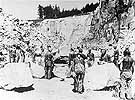
|
|
|

|

|

|

|
|
Click on an image to see a larger, more detailed picture.
|
|
|
|
|
| 1938: The End of Illusions |

|
pg. 137 |

|
|
|
|
| |
 The cover page of this German passport, issued to Karoline Ruelf, is stamped with the letter "J" for Jude (Jew). Heinrich Rothmund of the Swiss federal police instigated the recall of all Jewish passports. Swiss officials were worried that German Jews would attempt to pose as Christians and smuggle themselves into Switzerland. The large, red "J" on their passports was an attempt to curtail the movement of German Jews and reassure the Swiss government.
The cover page of this German passport, issued to Karoline Ruelf, is stamped with the letter "J" for Jude (Jew). Heinrich Rothmund of the Swiss federal police instigated the recall of all Jewish passports. Swiss officials were worried that German Jews would attempt to pose as Christians and smuggle themselves into Switzerland. The large, red "J" on their passports was an attempt to curtail the movement of German Jews and reassure the Swiss government.
Photo: Caroline Fierst/United States Holocaust Memorial Museum Photo Archive
|
 Mauthausen
Mauthausen
The Mauthausen concentration camp near Linz, Austria, specialized in working prisoners to death in its rock quarry. Of the 200,000 men, women, and children who passed through its gates, about 120,000 perished from neglect, overwork, and sadistic torture--the highest percentage of all camps within the Reich. The camp was designed according to the "Dachau model" and followed the established method of mistreating prisoners. But in addition to murder through starvation and beatings, Mauthausen also featured a unique brand of torture. It was devised by camp commander Franz "Babyface" Ziereis. Prisoners were forced to run up 186 steps from the camp's granite quarry, carrying stones weighing over 100 pounds. If dropped, they crushed the feet of those behind. Every Jew who dropped his load was beaten mercilessly, and the stones were again lifted to his shoulders. In despair, many committed suicide by leaping into the quarry from the cliff above. Some were thrown over the edge by guards, who referred to their victims as "parachute troops." Prisoners were also murdered by being forced to run into electrified fences, through shootings in the back of the neck, and with chemical injections directly into the heart.
Photo: Rijksinstituut voor Oorlogsdocumentatie/United States Holocaust Memorial Museum Photo Archive
|
|

|

|

|

|
 September 29-30, 1938: The Czech representatives to the conference, who had been forced to wait helplessly in the corridor outside the conference hall, break down into sobs after hearing the news of the Allied concessions to Germany. Also at the conference, Chamberlain signs a Friendship Treaty with Germany without informing his French ally. Arriving home, he triumphantly holds this scrap of paper up to the crowd that surrounds his airplane and promises "peace in our time."
September 29-30, 1938: The Czech representatives to the conference, who had been forced to wait helplessly in the corridor outside the conference hall, break down into sobs after hearing the news of the Allied concessions to Germany. Also at the conference, Chamberlain signs a Friendship Treaty with Germany without informing his French ally. Arriving home, he triumphantly holds this scrap of paper up to the crowd that surrounds his airplane and promises "peace in our time."
|
 October 1938: The Polish government revokes passports of all Jews who have lived outside of Poland for more than five years, rendering them stateless.
October 1938: The Polish government revokes passports of all Jews who have lived outside of Poland for more than five years, rendering them stateless.
|
|
|
|
|
| 1938: The End of Illusions |

|
pg. 137 |

|
|
The Holocaust Chronicle
© 2009 Publications International, Ltd.
|
|
